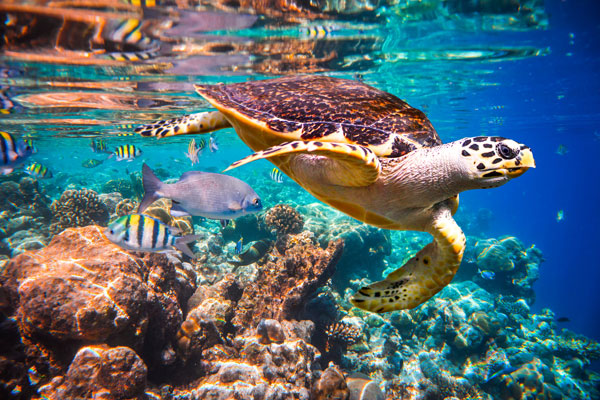
May 6, 2019; New York Times
A new 1,500-page United Nations report finds “that as many as one million plant and animal species are now at risk of extinction,” reports Brad Plumer in the New York Times. Yesterday, a summary of its findings, approved by representatives from 132 countries, including the US, was released.
While recognition of humanity’s global environmental impact is not new—leading some to label our present era the Anthropocene—the latest UN report paints a grim picture. In addition to foreseeing mass extinctions, other findings include:
- Land degradation has reduced the productivity of 23 percent of the global land surface, up to US$577 billion in annual global crops are at risk from pollinator loss.
- 100-300 million people are at increased risk of floods and hurricanes because of loss of coastal habitats and protection.
- In 2015, 33 percent of marine fish stocks were being harvested at unsustainable levels.
- Plastic pollution has increased tenfold since 1980.
- 300-400 million tons of heavy metals, solvents, toxic sludge and other wastes from industrial facilities are dumped annually into the world’s waters.
- Fertilizers entering coastal ecosystems have produced more than 400 ocean “dead zones” with a land area of nearly 95,000 square miles (larger than the United Kingdom).
Absent transformative change, these trends are expected to continue to 2050 and beyond. “For a long time, people just thought of biodiversity as saving nature for its own sake,” Robert Watson, chair of the Intergovernmental Science-Policy Platform on Biodiversity and Ecosystem Services, which conducted the assessment for the UN, tells Plumer. “But this report makes clear the links between biodiversity and nature and things like food security and clean water in both rich and poor countries.”
Standard approaches such as measures that protect individual species (such as the Endangered Species Act in the US) or wildlife refuges are inadequate to the task at hand, the report explains. Instead, what is required are more “transformative changes,” such as curbing wasteful consumption, reducing agriculture’s environmental footprint, and strict controls on logging and fishing.
Sandra Díaz, a lead author of the study and an ecologist at the National University of Córdoba in Argentina, adds that, “We need to build biodiversity considerations into trade and infrastructure decisions, the way that health or human rights are built into every aspect of social and economic decision-making.”
Sign up for our free newsletters
Subscribe to NPQ's newsletters to have our top stories delivered directly to your inbox.
By signing up, you agree to our privacy policy and terms of use, and to receive messages from NPQ and our partners.
The report notes that, since 1500, at least vertebrate 680 species have been driven to extinction “including the Pinta Giant Tortoise in the Galapagos in 2012.” But things could get a lot worse. The report notes that “an average of around 25 percent of species in assessed animal and plant groups are threatened…suggesting that around one million species already face extinction, many within decades, unless action is taken to reduce the intensity of drivers of biodiversity loss. Without such action there will be a further acceleration in the global rate of species extinction, which is already at least tens to hundreds of times higher than it has averaged over the past 10 million years.” At risk are 40 percent of amphibian species, a third of marine mammals and a third of reef-forming corals. More broadly, more than 500,000 land species face extinction risk “many within decades, unless their habitats are restored.”
Global warming, notes Plumer, makes matters worse. “Roughly five percent of species worldwide are threatened with climate-related extinction if global average temperatures rise two degrees Celsius above preindustrial levels, the report concluded. (The world has already warmed one degree.)”
Still, climate change is only one of many drivers of extinction. “If climate change were the only problem we were facing, a lot of species could probably move and adapt,” Richard Pearson, an ecologist at the University College of London, tells Plumer. “But when populations are already small and losing genetic diversity, when natural landscapes are already fragmented, when plants and animals can’t move to find newly suitable habitats, then we have a real threat on our hands.”
Declining biodiversity not only eliminates species from the planet, but also harms human welfare. “Most of nature’s contributions to people are not fully replaceable, and some are irreplaceable,” the report authors note.
There have been some successes. Conservation measures have saved some species, such as the Arabian Oryx and Przewalski’s Horse. The report adds that, “At least 107 highly threatened birds, mammals and reptiles (e.g. Island Fox and Seychelles Magpie-Robin) are estimated to have benefited from invasive mammal eradication on islands.” Plumer reports that 15 percent of the world’s land and seven percent of its oceans have set up nature reserves and wilderness areas, which still means most areas are unprotected.
Plumer notes that world diplomats will gather for meetings under the Convention on Biological Diversity, a global treaty, over the next two years to discuss how to step up their conservation efforts. But as Jake Rice, a leading Canadian fisheries scientist, tells Plumer, at this point “our options are all about damage control.”—Steve Dubb












